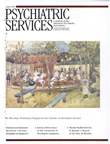Testing the limits of deinstitutionalization
Abstract
OBJECTIVE: From 1978 to 1993, under favorable administrative and political conditions and protected by a court-ordered consent decree, a comprehensive community-based mental health system was established in western Massachusetts that entirely replaced Northampton State Hospital. This paper examines that experience to describe the characteristics and comparative department of mental health expenditures on alternative treatment settings and to explore whether the need for state hospitals can be eliminated. METHODS: Data on distribution and department of mental health funding of services in western Massachusetts were compared with similar data from the rest of the state, where state hospital utilization remained relatively high. RESULTS: Between 1978 and 1992, department of mental health expenditures on noninpatient community services in western Massachusetts increased from 15 percent to 74 percent of total expenditures on adult mental health services. In 1992 per capita expenditures on such services in western Massachusetts and the rest of the state were similar. However, per capita expenditures for inpatient services constituted 27 percent of total expenditures in western Massachusetts, compared with 53 percent in the rest of the state. Western Massachusetts spent approximately twice as much per capita on residential and emergency services and one and a half times as much on case management services and support. Very few Northampton patients were transferred to nursing homes, and the inpatient census per 100,000 population supported by the department of mental health in western Massachusetts was one-third of that in the rest of the state. CONCLUSION: Under certain conditions, the role and functions of state hospitals can be completely replaced by a system of comprehensive community services.
Access content
To read the fulltext, please use one of the options below to sign in or purchase access.- Personal login
- Institutional Login
- Sign in via OpenAthens
- Register for access
-
Please login/register if you wish to pair your device and check access availability.
Not a subscriber?
PsychiatryOnline subscription options offer access to the DSM-5 library, books, journals, CME, and patient resources. This all-in-one virtual library provides psychiatrists and mental health professionals with key resources for diagnosis, treatment, research, and professional development.
Need more help? PsychiatryOnline Customer Service may be reached by emailing [email protected] or by calling 800-368-5777 (in the U.S.) or 703-907-7322 (outside the U.S.).



